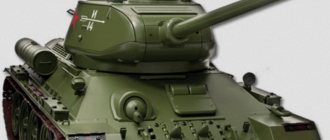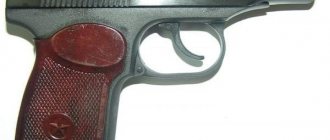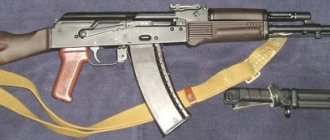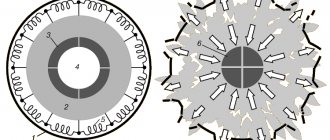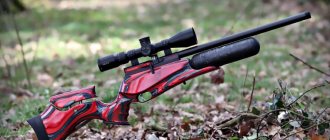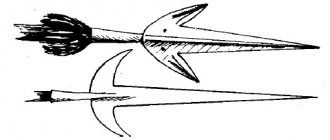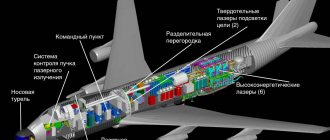Today, many armies around the world are armed with combat lasers based on ships, as well as compact lasers mounted on aircraft. How is the process of developing laser weapons going on in the world and, naturally, in Russia?
Not long ago, information appeared in the Western media that Great Britain had also joined the laser arms race, in which the United States and Germany were already taking part. Thus, one of the British companies plans to develop a deck-based laser system. However, the estimated power of the future weapon is not mentioned. And this goes without saying, because in world practice, similar developments are usually classified as “secret”.
It is clear that Russia is no exception, because to this day many developments are still secret. Such developments, carried out in parallel with the United States, were announced back in 2014 by the former chief of the Russian General Staff, Army General Yu. Baluevsky. Although work on combat lasers in our country was not interrupted. However, nowadays we are developing weapons that can disable the military satellites of a potential enemy.
Soviet developments of laser weapons
For a laser beam placed in a vacuum, neither the earth’s atmosphere nor the installation of smoke screens by the enemy will be an obstacle. Thanks to this, the laser installation will easily damage the optics of enemy satellites, and reconnaissance satellites without “eyes” will become a pile of useless metal that will self-destruct or leave their orbit and simply burn up in the upper atmosphere.
At first they learned to “shoot” at the enemy’s optics in terrestrial conditions. Such laser systems placed on self-propelled guns were used back in the Soviet Union in the early 1980s. Thus, NPO "Astrophysics" developed "Stilettos" - self-propelled serial laser systems. They countered the enemy's optical-electronic equipment.
Later they were replaced by “Sanguins” - complexes that had broader potential. For example, for the first time they used the “Shot Resolution System” to ensure direct guidance of combat lasers. Countering moving air targets with a range of eight to ten kilometers, they easily destroyed optical receiving devices.
In the mid-1980s, only the deck version of these laser systems was presented for testing events, which had the same characteristics and tasks and were then called “Aquilons”. Their purpose was to destroy optical-electronic equipment in the coast guard system of a potential enemy.
With the onset of the 90s, “Sanguins” were replaced by “Compressions”. These were self-propelled laser complexes developed at that time, which automatically searched for and also aimed at objects that glared from the radiation of multi-channel ruby solid-state lasers. It was practically impossible to find effective protection against twelve combat lasers in Compression complexes with a wide variety of wavelengths, with twelve filters simultaneously installed on the optics. However, the effectiveness of ground-based systems raised many doubts among the then military department.
It is possible that, as a result of this reason, all further tests of combat lasers were moved to airspace. "Stilettos", "Sanguins" and "Compressions" to some extent turned out to be the first ground test beds.
To conduct testing in airspace, Soviet scientists developed the A-60 flying laboratory, which housed a laser experimental unit based on the Il-76MD aircraft. The development of this program was carried out by the Beria people in cooperation with Almaz. For this purpose, a powerful one-megawatt laser was created on the basis of a branch of the Kurchatov Institute. During testing in April 1984, this installation successfully hit an aerial target. Then they used a combat laser system on a stratospheric balloon at an altitude of up to thirty to forty kilometers.
Russian laser weapons, what is known about them
A modernized laser complex, which was installed on another similar A-60 aircraft, and all work on these projects ceased back in 1993. However, all the accumulated experience was used in Sokol-Echelon. This was a new program, resumed in 2003 by Almaz-Antey.
Over the decades, work on this program was either curtailed or resumed. According to reports, it is still planned to install new generation combat lasers on the A-60 aircraft to test a complex for “blinding” space tracking equipment.
No longer exotic
“These are not exotic, not experimental or experimental products - we have already adopted individual samples of laser weapons,” said the now former Deputy Minister of Defense in charge of the Defense-Industrial Complex, Yuri Borisov at a gala meeting dedicated to the 70th anniversary of the Russian Federal Nuclear Power Plant center in Sarov, in August 2016.
There was information in the media that work on the long-forgotten 1A2 aviation laser complex, created on the basis of the Il-76 military transport aircraft, is in full swing in the country. It was also reported that the Astrophysics research and production association (part of the Shvabe holding of the Rostec state corporation) brought back to life the forgotten project 1K17 “Compression” - a laser complex built on the basis of a tank and designed to counter optical-electronic devices , homing heads of enemy missiles and precision-guided ammunition. If in Soviet times it was located on the base of a tank, now it fits in the “body” of the Tiger armored car.
It is appropriate to mention that specialists from the Federal State Unitary Enterprise “Krylov Scientific Center” - an institute without whose decision not a single ship project will be implemented in metal - say that new nuclear reactors have been created in the country for promising ships and RITM 200 vessels, producing 175 megawatts of power. Their appearance made it possible to lay down a series of the largest and most powerful icebreakers of the new generation of Project 22220 “Arktika”, and in the future they should also be equipped with new generation destroyers of Project 23560 “Leader”. In the case of the latter, the Krylovites openly say that laser and electromagnetic guns can be deployed on them.
Russian lasers are not known for their weapons alone.
Along with this, it should be noted that the use of lasers is not limited only to the most diverse types of weapons, but also as a means of targeting them. Great strides have been made in this direction. For example, Radioelectronic Technologies developed a multi-channel laser-beam guidance system used in many combat helicopters.
The presented system ensures high accuracy in missile guidance. Thanks to this, helicopters can use missiles of various modifications. The purpose of the laser-beam system is to perform motion control tasks and bring guided missiles to the target, captured and held by tracking machines or operators in manual modes.
According to many experts, modern Russian laser technologies fully meet all requirements. Such systems can be installed not only on helicopters, but also on ground vehicles, man-portable air defense systems and drones.
Moreover, with the help of laser technologies it is possible to effectively counteract modern anti-aircraft missile systems. For example, Ekran, part of KRET, has developed a laser system for optical-electronic suppression. The system ensures reliability and effectiveness in countering a wide variety of MANPADS.
One of the most famous such developments was the President-S system. During testing against a wide variety of aircraft targets, not a single target was hit by the Igla.
Laser weapons in the USA
As always, quite reasonable questions arise about how things are going in these areas in one of the main potential overseas potential adversaries - in the United States? For example, Colonel General Leonid Ivashov, President of the Academy of Geopolitical Problems, states something like this.
For Russia, the presence of powerful chemical lasers placed on board Boeing 747s or on platforms located in outer space could be potentially dangerous. By the way, these laser systems are still Soviet developments, transferred in the 90s by order of then President Yeltsin to the Americans.
And what’s interesting is that just recently the American press was discussing the appearance of an official statement from the Pentagon. It said that testing of combat laser systems to counter ballistic missiles intended for deployment on aircraft carriers went well. In addition, it turned out that the US Missile Defense Agency received permission from Congress to finance testing programs for laser systems back in 2011 for one billion dollars.
According to the plan of the American military department, aircraft equipped with laser weapons are supposed to be used primarily against medium-range missile systems. However, most likely, they will be used only against operational-tactical missile systems. The destructive radius of such combat lasers, even under ideal conditions, is limited to a maximum of three hundred and fifty kilometers. Thus, it turns out that in order to shoot down a ballistic missile during acceleration, an aircraft equipped with a combat laser system must remain within a radius of one hundred to two hundred kilometers from the location of the missile launchers.
However, positions with intercontinental ballistic missiles are deployed mainly in the middle of the state’s territory. It is clear that if any aircraft accidentally ends up in such regions, it will undoubtedly be destroyed. As a result, the adoption of air-launched lasers by the US military can only provide some hindrance to potential threats from states that are familiar with missile technology first-hand, but do not have full-fledged air defense.
Today, Americans are experimenting with several combat laser systems. For example, one of these is the ATL airborne complex. It is supposed to be placed on a C-130 transport aircraft. The main purpose of this laser system is to combat unarmored ground targets.
However, this system has a number of imperfections:
- The system can fire accurately and extremely effectively only from close distances;
- The system, despite its multi-million dollar investment, can be easily destroyed by any anti-aircraft missile system.
Currently, the most publicized American program is the ABL-1Y flying missile defense laser project, which is placed on Boeing 747s. Their main purpose is to eliminate ballistic missiles that are just starting to launch from launch silos. The development of this system began in the early 90s, and the idea to create such a laser system was based on another experimental laser system NKC-135A, which was tested back in the early 80s.
However, in those distant years, when the Cold War was still in full swing, the main targets could have been missile systems used in close air combat. As a result of testing, one interesting fact emerged. The military had to refute the previously stated firing range of up to sixty kilometers. In reality, it did not exceed five kilometers. Nevertheless, the Americans are searching for ways to create effective means of eliminating missiles launching at ranges of up to five hundred kilometers. The main goal of this search is to prevent any ballistic missiles from being launched from Russian submarines.
Despite the colossal funds allocated annually by the American government for the development of laser weapons, no real achievements have yet been observed. The biggest achievement that the American military department can be proud of so far is hitting several targets simulating ballistic missiles. However, there was no mention of target ranges and speeds.
New in blogs
The publication https://topwar.ru/3920.html and some other media at different times reported on the development of laser weapons in the USSR and in Russia, the materials of which are selected in this article.
At one time, the United States planned to place interceptor satellites in low-Earth orbit capable of destroying Soviet ballistic intercontinental missiles on their initial flight path. This program was called the Strategic Defense Initiative (SDI). It was SDI that gave impetus to the active development of laser weapons in the USSR.
In the Soviet Union, several experimental models of laser space guns were developed and built to destroy American interceptor satellites. At that time, they could only operate with powerful ground-based power sources; installing them on a military satellite or space platform was out of the question.
But despite this, experiments and tests continued. It was decided to carry out the first testing of the laser gun in sea conditions. The gun was installed on the auxiliary fleet tanker Dixon. In order to obtain the required energy (at least 50 megawatts), the tanker's diesel engines were reinforced with three jet engines from the Tu-154. According to some reports, several successful tests were carried out to hit targets on the shore. Then perestroika and the collapse of the USSR happened, all work stopped due to lack of funding. And the “laser ship” “Dixon” went to Ukraine during the division of the fleet. His further fate is unknown.
At the same time, work was underway to create the Skif spacecraft, which could carry a laser gun and provide it with energy. In 1987, the launch of this device, which was called “Skif-D,” was supposed to take place. It was created in record time at NPO Salyut. A prototype of a space fighter with a laser cannon was built and ready for launch; at the start there was an Energia rocket with an 80-ton Skif-D device docked on the side. But it so happened that it was at this time that the famous guardian of US interests, Gorbachev, arrived at Baikonur. Having gathered the Soviet space elite in the conference hall of Baikonur three days before the launch of Skif, he stated: “We are categorically against transferring the arms race into space and will set an example in this.” Thanks to this speech, “Skif-D” was launched into orbit only to be immediately thrown into the dense layers of the atmosphere for burning.
But in fact, the successful launch of Skif would mean a complete victory for the USSR in the struggle for near space. For example, each Polet-type fighter could destroy only one enemy aircraft, while it itself died. “Skif” could fly in orbit for quite a long time, while hitting enemy vehicles with its cannon. Another indisputable advantage of the Skif was that its gun did not require a special range; 20-30 km of action would have been enough to destroy the intended targets of vulnerable orbital satellites. But the Americans would have to puzzle over space stations firing thousands of kilometers away at small armored warheads rushing at breakneck speed. “Scythians” shot down satellites while catching up, when the speed of the pursued target in relation to the hunter can be said to be simply snail-like.
Maneuvering satellite "Polyot-1"
It turns out that the Skif fleet would smash into pieces the American low-orbit constellation of military satellites with a 100% guarantee. But all this did not happen, although the remaining scientific and technical base is an excellent basis for modern developers.
The next development of the Salyut Design Bureau was to be the Skif-Stiletto apparatus. The prefix “Stiletto” appeared in the name because they were going to install on it the onboard special complex (BSK) 1K11 “Stiletto” developed at NPO Astrophysics. It was a modification of the “ten-barreled” ground-based infrared laser installation of the same name, operating at a wavelength of 1.06 nm. The ground-based “Stiletto” was intended to disable sights and sensors of optical devices. In the vacuum of space, the radius of action of the rays could be significantly increased. The “Space Stiletto” could, in principle, be successfully used as an anti-satellite weapon. As is known, failure of the optical sensors of a spacecraft is tantamount to its death. What happened to this project is unknown.
In a conversation with journalists at that time, the Chief of the General Staff of the Armed Forces of the Russian Federation, Nikolai Makarov, stated that in Russia, “as well as throughout the world, work is underway on a combat laser.” Adding: “It is too early to talk about its characteristics.” Maybe he was talking about the development of this particular project.
According to Wikipedia, the fate of the ground-based Stiletto is also very sad. According to some reports, neither of the two copies adopted for service is currently operational, although formally the Stiletto is still in service with the Russian army.
Laser complex "Stilet" at state tests
Photos of one of the Stilet complexes, 2010, Kharkov Tank Repair Plant No. 171
Some experts believe that during the parade on May 9, 2005, Russia demonstrated laser guns, and not “prototypes,” but production vehicles. Six combat vehicles with their “combat units” and “terminal devices” removed stood on both sides of Red Square. According to experts, these were the same “laser guns”, which were immediately dubbed “Putin’s hyperboloid” by wits.
New - well forgotten old
Russia has also decided to resume development of a combat aircraft laser capable of hitting aircraft, satellites and ballistic missiles. The USSR created weapons of this type back in the 70s. In general, the Soviet Union became interested in combat lasers in the mid-60s, and by 1973 a special design bureau was created. The first air-launched installation was placed on an experimental A-60 aircraft based on the Il-76 transport aircraft. He made his first flight with a laser on board in 1983. In 1984, Soviet pilots hit the first aerial target with a beam, and by 1991, testers already had two A-60s. But then the funding ran out and the program was frozen.
Work in the design bureaus was actually carried out on the personal initiative of the employees. Only in 2009, the resumption of work on an aircraft laser was announced by the current academic adviser to the Russian Academy of Engineering Sciences, Yuri Zaitsev. It was all about the same A-60 aerial laboratory, on which the “blinding laser” was placed. Its task is to influence the optical homing heads of ballistic missiles and satellite surveillance systems. However, there is no information yet on whether any success has been achieved. In 2011, the project was again left without funding, and the equipment from the only remaining A-60 was partially dismantled.
Funding for laser development in the interests of the Russian Ministry of Defense resumed in 2012. Now it is planned to install a more powerful device on the A-60. This refers to the new units of the 1LK222 installation, developed by Khimpromavtomatika (in the ground version - Sokol-Echelon). Its tests were planned for 2013, but first the carrier must undergo modernization. The military department has not yet decided which types of aircraft to install combat lasers on. These will probably be military transport aircraft and bombers.
In addition to the A-60, other interesting programs were carried out in Russia. In the early 90s, a prototype of a mobile laser gun was created based on the Msta-S self-propelled howitzer. The project, called 1K17 "Compression", used a multi-channel solid-state laser. According to unconfirmed reports, an artificial cylindrical ruby crystal weighing 30 kilograms was grown especially for “Compression.” There is also a version that the body of the laser was yttrium aluminum garnet with neodymium additives.
The development of the Compression laser complex was carried out by NPO Astrophysics. The chief designer in the direction was N.D. Ustinov. The development of the chassis and installation of the on-board special complex was carried out by Uraltransmash, under the leadership of Yu.V. Tomashov.
In December 1990, a prototype of the vehicle was assembled; in 1991, 1K17 was sent for state tests, which ended in 1992, after which the complex was recommended for adoption. However, despite the positive test results, the collapse of the USSR, the revision of government funding for defense programs, the high cost of the complex and other economic factors forced the Russian Ministry of Defense to doubt the need for such complexes, so the vehicle was not sent into mass production.
In 1993, the project was stopped. Taking into account the increased interest of the Ministry of Defense in promising developments, many ground and airborne laser systems may well get a second life. For similar purposes, in October 2012, Russian Deputy Prime Minister Dmitry Rogozin initiated the creation of the Advanced Research Foundation. Apparently, he will not spare money on high-risk research and development.
The electronic directory of the Ministry of Defense of the Russian Federation “Weapons of Russia” reports: “Experts in this field, despite contradictory and unproven data due to the closed nature of this topic, assess the prospects for the creation of military laser weapons in Russia as realistic. This is due, first of all, to the rapid development of modern technologies, the expansion of the use of laser weapons for other purposes, the desire to create such weapons and the advantages that they have in comparison with traditional means of destruction. According to some estimates, the real appearance of military laser weapons is possible in the period 2015-2020.”
However, other experts are not so optimistic about the prospects of laser weapons, which will be discussed in more detail in the next publication.
Systems for protection against combat laser weapons
It is clear that if the development of means for delivering strikes is underway, then, in theory, the development of protective systems or countermeasures must also be carried out. So, back in the 80s, ballistic missile developers took some countermeasures against the potential threat from combat laser systems and missile defense. Thus, defense enterprises began to install special equipment in the middle of warheads for complex means to counter all types of missile defense. The main methods of protection against combat laser systems can be aerosol clouds consisting of a suspension of absorbing rays. Adding rotational torque to missiles can also lead to some “blurring” of explosive hot spots over most of the target surfaces.
Ground-based types of laser weapons
The development of ground-based laser systems has recently proven to be a widespread topic. Many Western countries have seriously begun the secret development of these weapons, under the guise of good intentions related to the fight against world terrorism.
The Chinese army immediately got involved and began placing laser turrets on their new ZTZ-99G tanks. They are engaged in disabling the enemy's optical systems and partially blinding the gunner. Although further development of new types of these weapons, the Chinese government had to temporarily freeze. The Soviet developments of ground-based combat laser systems have already been mentioned above.
At present, it has become obvious to everyone that the massive appearance of real powerful combat laser systems in the armed forces of any, even the most technologically advanced, country cannot be expected over the next decades. With all this, there is also a refusal of research activities in this direction.
It is possible that future developers can solve those important issues that currently make the scope of application of combat laser systems extremely limited. Naturally, over time, the Pentagon will even launch lasers into low-Earth orbit, which means the Russian military also needs to be prepared for countermeasures. And then, our engineering minds will have to continue to work on the previously started work on creating attack laser systems and, naturally, develop complex systems to protect against them.
The Chinese presented a laser gun with a range of almost a kilometer
Scientists from the Xi'an Institute of Optics and Precision Mechanics at the Chinese Academy of Sciences announced a new development - the ZKZM-500 laser gun.
The laser beam generated by a gun is very difficult to notice from the outside; these are the colored rays of “blasters” not shown in science fiction. However, in many cases, a laser rifle is much more effective than movie weapons, which, as a rule, hit the enemy only in exceptional cases. According to the developers, although the weapon belongs to the “non-lethal” class, the energy of the beam is enough to cause instant charring of skin and tissue. Just ten years ago, such a rifle was only the property of Hollywood studios, but now it is a very real weapon. The engineers who developed the gun say that the beam will hit a person through clothing without any problems. Moreover, if the fabric from which the clothes are made is flammable, then a person wearing these clothes can turn into a living torch. The gun is designed so that it can be used on foot, attached to a car or aircraft. The weight of the gun is 3 kg, about the same weight as the Kalashnikov AK-47 assault rifle. Now the Chinese are deciding to start mass production of laser weapons and provide them to anti-terrorism teams and special police units.
In the event of hostage taking by terrorists, such paramilitary units will be able to temporarily incapacitate the criminals and remove the hostages.
Of course, weapons of this kind can also be used during military operations. You don't have to shoot at people - you can point a laser rifle at a fuel storage facility and ignite it. It is worth remembering that the rifle is silent, there will be no sound of a shot, so the enemy may not understand what happened. Everything will look like a random accident. And of course, it will be impossible to track the direction from which the shot was fired.
The rifle will have more than enough charges. Its battery (regular rechargeable Li-ion) is enough for 1000 shots of 2 seconds each. Range - 800 m. The prototype rifle was built on the basis of the ZKZM laser, previously developed by Xi'an University. The developers are now looking for a partner who has a license to produce weapons. The cost of one rifle is about $15,000.
The production of weapons of this type will be supervised to ensure that neither prototypes nor drawings fall into the hands of potential terrorists or other criminals. As far as can be understood, China does not yet plan to transfer technology to third parties - for example, the military of other countries.
The gun actually exists and works - technical documentation with basic information was published on one of the government websites. These are only the main characteristics, without a detailed indication of the operating principles of the rifle and its individual elements. In addition to the rifle, other types of laser weapons are now being actively developed, including a laser machine gun. Its range is short - about half a kilometer, but the machine gun can shower the enemy with a hail of laser beams. The battery also lasts for several hundred shots.
Laser weapons began to be developed only a few years ago. One of the first was the US military, which created a laser cannon, which in the end turned out to be not very successful. The laser power was not even enough to pass through clothing, so, according to eyewitnesses, only nudists could become victims of such a gun. But they are rare on the battlefield, so they did not introduce the cannon. After this, the United States developed laser guns for ships and aircraft. They were used, in particular, to destroy enemy missiles.
The Chinese took laser weapons most seriously. In 2015, the Chinese authorities allocated about 2 billion yen (approximately $111 million) for the development of weapons of this type. And after this became known, other countries began to develop laser weapons.
In China, as far as one can judge, stationary laser weapons have become the norm. In particular, the US military, which has been operating in the Indian Ocean and the South China Sea in recent years, has complained about certain laser installations at Chinese bases. Two US military pilots suffered eye damage due to these installations.
Miniaturization of laser technology has become possible thanks to significant progress in science and technology over the past few years. We see miniaturization of approximately the same importance and speed of progress in computer technology. We can probably say that military affairs is entering a new stage of evolution.


